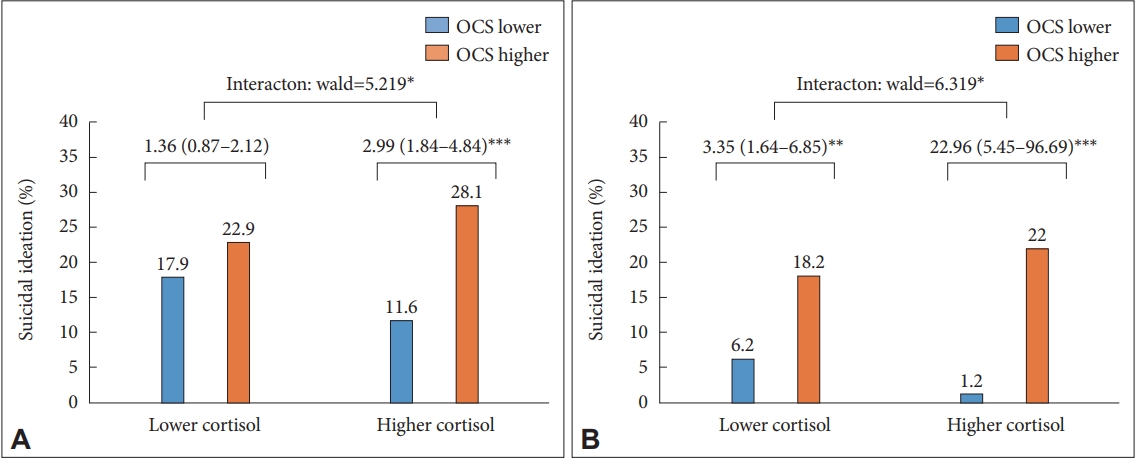2. Virani SS, Alonso A, Benjamin EJ, Bittencourt MS, Callaway CW, Carson AP, et al. Heart disease and stroke statistics-2020 update: a report from the American Heart Association. Circulation 2020;141:e139-e596.

3. Larsen KK, Agerbo E, Christensen B, Søndergaard J, Vestergaard M. Myocardial infarction and risk of suicide: a population-based case-control study. Circulation 2010;122:2388-2393.


5. Kim JM, Kang HJ, Bae KY, Kim SW, Shin IS, Hong YJ, et al. Determinants and escitalopram treatment effects on suicidal ideation in patients with acute coronary syndrome: findings from the K-DEPACS and EsDEPACS studies. Int J Cardiol 2016;219:225-230.

10. Hantouche EG, Angst J, Demonfaucon C, Perugi G, Lancrenon S, Akiskal HS. Cyclothymic OCD: a distinct form? J Affect Disord 2003;75:1-10.


11. Velloso P, Piccinato C, Ferrão Y, Aliende Perin E, Cesar R, Fontenelle L, et al. The suicidality continuum in a large sample of obsessive-compulsive disorder (OCD) patients. Eur Psychiatry 2016;38:1-7.


13. Westrin A, Ekman R, Träskman-Bendz L. Alterations of corticotropin releasing hormone (CRH) and neuropeptide Y (NPY) plasma levels in mood disorder patients with a recent suicide attempt. Eur Neuropsychopharmacol 1999;9:205-211.


14. Lindqvist D, Isaksson A, Träskman-Bendz L, Brundin L. Salivary cortisol and suicidal behavior--a follow-up study. Psychoneuroendocrinology 2008;33:1061-1068.


15. O’Connor DB, Ferguson E, Green JA, O’Carroll RE, O’Connor RC. Cortisol levels and suicidal behavior: a meta-analysis. Psychoneuroendocrinology 2016;63:370-379.


17. Kawano A, Tanaka Y, Ishitobi Y, Maruyama Y, Ando T, Inoue A, et al. Salivary alpha-amylase and cortisol responsiveness following electrical stimulation stress in obsessive-compulsive disorder patients. Psychiatry Res 2013;209:85-90.


18. Sousa-Lima J, Moreira PS, Raposo-Lima C, Sousa N, Morgado P. Relationship between obsessive compulsive disorder and cortisol: systematic review and meta-analysis. Eur Neuropsychopharmacol 2019;29:1185-1198.


19. Hamideh Pour OJ, Iraj S, Bahman AK. Compare the obsessive-compulsive disorders between coronary heart disease and healthy subjects. J Nov Appl Sci 2014;3:283-286.
21. Derogatis LR. SCL-90-R: administration, scoring & procedures manual-II for the r(evised) version and other instruments of the psychopathology rating scale series. 2nd ed. Towson, MD: Clinical Psychometric Research; 1992.
22. Follick MJ, Gorkin L, Smith TW, Capone RJ, Visco J, Stablein D. Quality of life post-myocardial infarction: effects of a transtelephonic coronary intervention system. Health Psychol 1988;7:169-182.


23. Allison TG, Williams DE, Miller TD, Patten CA, Bailey KR, Squires RW, et al. Medical and economic costs of psychologic distress in patients with coronary artery disease. Mayo Clin Proc 1995;70:734-742.


25. Ehlert U, Gaab J, Heinrichs M. Psychoneuroendocrinological contributions to the etiology of depression, posttraumatic stress disorder, and stress-related bodily disorders: the role of the hypothalamus-pituitary-adrenal axis. Biol Psychol 2001;57:141-152.


26. Raison CL, Miller AH. When not enough is too much: the role of insufficient glucocorticoid signaling in the pathophysiology of stress-related disorders. Am J Psychiatry 2003;160:1554-1565.


27. Choi W, Kang HJ, Kim JW, Kim HK, Kang HC, Lee JY, et al. Associations of serum cortisol levels, stress perception, and stressful events with suicidal behaviors in patients with depressive disorders. J Affect Disord 2022;297:602-609.


29. Montgomery SA, Åsberg M. A new depression scale designed to be sensitive to change. Br J Psychiatry 1979;134:382-389.


30. Kim JM, Kim SW, Kang HJ, Bae KY, Shin IS, Kim JT, et al. Serotonergic genes and suicidal ideation 2 weeks and 1 year after stroke in Korea. Am J Geriatr Psychiatry 2014;22:980-988.


31. Murrough JW, Soleimani L, DeWilde KE, Collins KA, Lapidus KA, Iacoviello BM, et al. Ketamine for rapid reduction of suicidal ideation: a randomized controlled trial. Psychol Med 2015;45:3571-3580.


32. American Psychiatric Association. Diagnostic and statistical manual of mental disorders. 4th ed. Washington, DC: American Psychiatric Association; 1994.
33. Killip T 3rd, Kimball JT. Treatment of myocardial infarction in a coronary care unit. A two year experience with 250 patients. Am J Cardiol 1967;20:457-464.

34. Khosravani V, Sharifi Bastan F, Samimi Ardestani M, Jamaati Ardakani R. Early maladaptive schemas and suicidal risk in an Iranian sample of patients with obsessive-compulsive disorder. Psychiatry Res 2017;255:441-448.


35. Kim M, Shim Y, Kwon J, Bae S, Lee J, Cha J, et al. Resting-state thetaphase gamma amplitude coupling as a biomarker for the transdiagnostic dimensional approach in psychiatric disorders. Psychiatry Clin Neurosci 2023;Apr 8 [Epub].
https://doi.org/10.1111/pcn.13554.

37. Santos CO, Caeiro L, Ferro JM, Figueira ML. A study of suicidal thoughts in acute stroke patients. J Stroke Cerebrovasc Dis 2012;21:749-754.


38. Nascimento ER, Maia AC, Soares-Filho G, Nardi AE, Cardoso A. Predictors of suicidal ideation in coronary artery disease. Compr Psychiatry 2015;57:16-20.


39. Green KL, Brown GK, Jager-Hyman S, Cha J, Steer RA, Beck AT. The predictive validity of the beck depression inventory suicide item. J Clin Psychiatry 2015;76:1683-1686.












